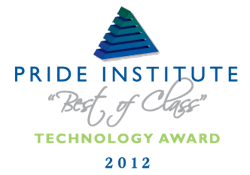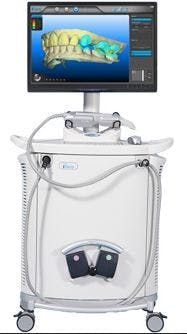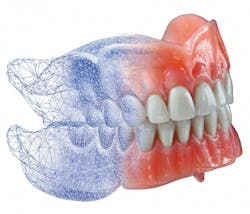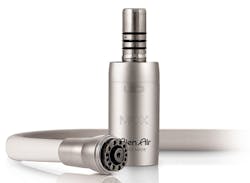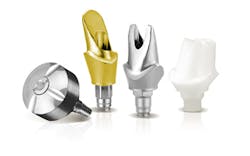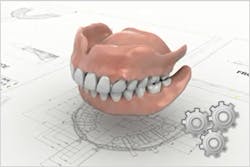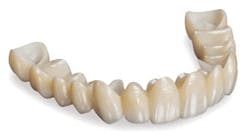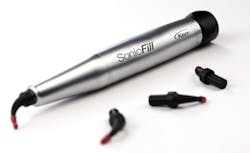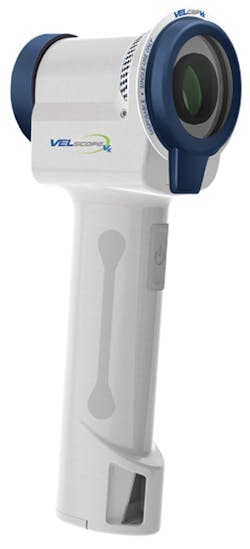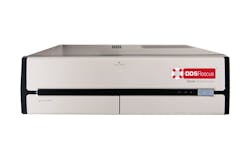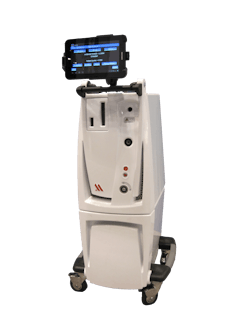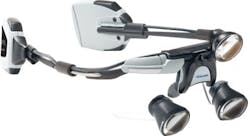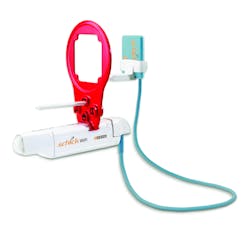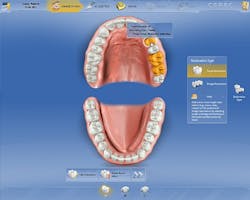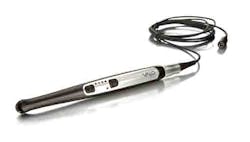Pride Institute's 2012 Best of Class Winners
Take a look at the 2012 award winners.
Air Techniques: Spectra Caries Detection Aid
What they say about it: The Spectra can be used to detect Fractured Tooth Syndrome, plaque and caries. The fluorescence technology of the spectra indicates extent of decay with color and numerical readings, which eliminates the guesswork for early caries detection. Dentists know that early detection means pinpointing problems at an earlier stage, which traditionally go undetected. This leads to more conservation and less excavation. Your practice’s case acceptance will increase from the impressive, information-rich images displayed by the Spectra. The Spectra can be used during the caries removal process to ensure all carious dentin is removed, and it also lets you store and compare images over time to track the effect of your treatment. The Spectra works with virtually any patient management software and connects to your computer with a USB cable.
What Dr. Paul says: Caries detection goes beyond the explorer. New technology allows the practitioner to find early lesions, allowing for conservative treatments. The old terms “watch and wait until it gets big enough to fill” go back to conventional amalgam preparations. New materials and techniques that allow saving tooth structure mandate the use of equipment such as the Spectra.
Where you can learn more: see a demonstration of the Spectra Caries Detection Aid.
Align Technology: iTero™ Digital Impression System
What they say about it: Designed to replace the uncomfortable and imprecise method of conventional impression taking, The iTero™ digital impression system is an exciting new technology that is light years ahead of cumbersome and expensive digital impression systems available today. Powered by proprietary imaging technology, iTero enables the dentist to take a digital scan of the patient’s teeth and bite, make any necessary adjustments in real-time, and then transmit the file via a wireless Internet connection to a Cadent-partnering laboratory for further processing. From there, the digital file is transmitted to Cadent, where a model is milled. This accurate physical model, die, and wax coping are then milled and sent to the laboratory, where a precise final restoration may be fabricated.
What Dr. Paul says: Digital impressions have become validated with many studies regarding the accuracy versus traditional impressions. Dental labs now are depending more on scanned impressions and models to have a more efficient and accurate workflow, while saving time and money in the process. Last year, there were only four systems commercially available to create intraoral impressions, two with the capability of creating restorations in the office while all four allowed export to the lab. Dentist and laboratories gave high grades to the iTero system, but all new systems should be evaluated by practitioners.
Where you can learn more: see a demonstration of the iTero Digital Impression System.
Avadent: Digital Dentures
What they say about it: AvaDent™ Digital Dentures make it easy for you to enter the digital age of removable prosthetics using standard clinical procedures with no additional computer skills or capital investment required. All you need to do is take impressions and use our patented AvaDent Measurement Device (AMD) to record all the necessary information to deliver an AvaDent Digital Denture to your patient. The heart of the AvaDent™ Digital Denture is the breakthrough software that controls the manufacturing process. Developed over the last several years by leaders in the digital dentistry field, AvaDent software takes the information from your impressions and AMD along with your prescription choices and automatically creates a virtual, best-fit set-up. From there our highly trained technicians have the never-before-ability to virtually adjust critical parameters, within minute tolerances, to create a prosthesis with exceptional function and aesthetics.
What Dr. Paul says: While digital impressions of teeth have become mainstream, denture impressions still depend on traditional methods. Until now, there has been little change in the laboratory setting and processing of dentures. Avadent and Dentca are receiving the impressions and scanning them, and with some innovative in-office procedures regarding centric, vertical and other measurements, many steps have been eliminated, as well as guesswork in the office and the laboratory. It is amazing to see the setup being done on a computer screen and transferred to “printed” try-in with Dentca or an actual milled denture base with slots for the teeth using Avadent.
Where you can learn more: see a demonstration of the Digital Dentures.
Bien-Air: MCX-LED Micromotor
What they say about it: The MCX-LED micromotor is the smallest electric motor ever designed by Bien-Air. Ultra-light and compact, it measures 40% shorter and 33% lighter than previous generations’ motors and competitors. The MCX-LED motor is brushless, autoclavable, maintenance free, features adjustable LED light, and is fully integratable into any dental unit. Perfect speed control at a constant torque, with a speed range of 1,000-200,000 RPM achieved with only two attachments, the MCX offers unmatched versatility to the dental practitioner. Contact Bien-Air at (800) 433-2436 to schedule a free in-office demo.
What Dr. Paul says: Dentists use both air turbine and electric handpieces. Electrics have the advantage of being “more powerful” with a higher maximum torque, but in reality it is the ability to fine tune the speed and torque for each procedure that is the appeal to many. One of the downsides has been the weight and balance of both the handpiece and the hosing and in some smaller hands they were quite uncomfortable. BienAir and Kavo had pioneered the shorter, lighter electric handpiece taking slightly different approaches as noted. It behooves the dentist to revisit electrics if it has been a while.
Where you can learn more:see a demonstration of the MCX-LED Micromotor.
Biomet 3i: BellaTek Encode Impression System
What they say about it: The Encode Impression System allows doctors to restore dental implants without the use of impression copings. The clinician simply makes a supragingival impression of the Encode Healing Abutment, sends it to the laboratory and in return, receives a patient specific abutment and crown ready for cementation. With the Encode Impression System, all that is needed for you to receive a patient specific abutment and final restoration are: an impression of the Encode Healing Abutment and the opposing arch, a bite registration, and a shade selection. Special codes embedded on the occlusal surface of the Encode Healing Abutment are captured in the Encode Cast that is poured by the dental laboratory and sent to BIOMET 3i. These codes provide the essential information (implant depth, hex-orientation, platform diameter and Certain® Internal Connection or External Connection interface) for placement of the dental implant analog in the master cast robotically (Robocast) and to design and mill the final abutment. Increasing productivity has never been easier than with the Encode Impression System.
What Dr. Paul says: Abutment impressions can often be stressful, especially when trying to screw in the impression coping on the most posterior tooth. The verification radiograph can also present a challenge when the patient cannot close on the coping. A triple tray is also not possible with many of the systems. The Encode is as close to a no-brainer impression as you can get. The patient is in and out in the time it takes for the material to set. The ensuing CAD/CAM technology for the manufacture of the abutment (and restoration) is simple and predictable.
Where you can learn more: see a demonstration of the BellaTek Encode Impression System.
DENTCA: CAD/CAM Denture
What they say about it: By using CAD and CAM systems, DENTCA is capable of greatly reducing the manufacturing time and the cost of making the final dentures. DENTCA only requires one patient visit before final denture delivery, compared to five visits required by conventional methods. By reducing the number of visits, the total chair time is also reduced from three hours to only 45 minutes, meaning dentists can now save time and see more patients. Moreover, the processing time for DENTCA products takes about 10 days on average, whereas conventional dentures require at least 30 days for production. Not only does DENTCA manufacture dentures at a rapid pace, but enhances the final denture quality due to perfect 3D modeling and production techniques. Not only that, but the 3D impression is a permanent digital record DENTCA can always access in the event a replacement or additional set is needed for the patient. From start to finish, the cost-effectiveness and productivity of DENTCA denture solutions are in a league of their own, far beyond those of conventional denture products.
What Dr. Paul says: While digital impressions of teeth have become mainstream, denture impressions still depend on traditional methods. Until now, there has been little change in the laboratory setting and processing of dentures. Avadent and Dentca are receiving the impressions and scanning them, and with some innovative in-office procedures regarding centric, vertical and other measurements, many steps have been eliminated, as well as guesswork in the office and the laboratory. It is amazing to see the setup being done on a computer screen and transferred to “printed” with Dentca or an actual milled denture base with slots for the teeth using Avadent.
Where you can learn more: see a demonstration of the CAD/CAM Denture.
Glidewell Dental Lab: BruxZir® Solid Zirconia
What they say about it: BruxZir® Solid Zirconia is a monolithic zirconia crown, bridge, screw-retained implant crown, inlay or onlay with no porcelain overlay. More brawn than beauty, you'll be impressed by the esthetics of BruxZir when prescribed instead of metal occlusal PFMs and cast gold restorations. BruxZir, because of its chip-proof durability, is an ideal solution for bruxers who have destroyed their natural teeth or existing dental restorations. Designed and milled using CAD/CAM technology, BruxZir is sintered for 6.5 hours at 1,530 degrees Celsius. The final BruxZir Solid Zirconia crown or bridge emerges nearly "bulletproof" and is glazed to a smooth surface. BruxZir Solid Zirconia crowns and bridges are backed by Glidewell Dental Lab's seven-year free replacement warranty.
What Dr. Paul says: BruxZir is replacing traditional PFM restorations. Made from a solid material that is strong (even in fine margins and veneers) has made this the go-to material for strong posterior restorations. As of press time, the lab was trying to improve the aesthetics for critical anterior restorations. Even with minimal (0.3mm) clearance and fine thin margins, this material is a winner. There is also no over-contouring at the margins, which is common in order to hide the metal of a PFM. Witness a demonstration of a veneer being hammered into a block of wood and you will be convinced that this new technology is something to seriously consider.
Where you can learn more: see a demonstration of the BruxZir Solid Zirconia.
Kavo Dental: COMFORTdrive Electric Handpiece
What they say about it: KaVo COMFORTdrive 200 XDR features KaVo’s industry-leading chuck strength. The chuck strength delivers exceptional bur concentricity for precise cutting and safety. The bur concentricity and chuck strength further establish KaVo COMFORTdrive 200 XDR as the Dental handpiece for all your high-speed handpiece needs. Sleek and compact, the COMFORTtronic module neatly incorporates into any operatory, offering an aesthetic, clean look in your dental practice. Simply dedicate the high-speed slot in your dental unit to COMFORTdrive and maintain your existing low-speed option. COMFORTdrive will be available as an integrated option into the Pelton & Crane Spirit 3000 series of delivery units soon.
What Dr. Paul says: Dentists use both air turbine and electric handpieces. Electrics have the advantage of being “more powerful” with a higher maximum torque, but in reality it is the ability to fine tune the speed and torque for each procedure that is the appeal to many. One of the downsides has been the weight and balance of both the handpiece and the hosing and in some smaller hands they were quite uncomfortable. BienAir and Kavo had pioneered the shorter, lighter electric handpiece taking slightly different approaches as noted. It behooves the dentist to revisit electrics if it has been a while.
Where you can learn more: see the COMFORTdrive Electric Handpiece in use here.
Kerr Corporation: SonicFill
What they say about it: SonicFill is a unique bulk fill system comprised of a specially designed handpiece and new composite material in Unidose tips. SonicFill’s composite incorporates a highly-filled proprietary resin with special modifiers that react to sonic energy. Simply stated, there is no other technology like it on the market today! As sonic energy is applied through the handpiece, the modifier causes the viscosity to drop (up to 87%), increasing the flowability of the composite enabling quick placement and precise adaptation to the cavity walls. When the sonic energy is stopped, the composite returns to a more viscous, non-slumping state that is perfect for carving and contouring.
What Dr. Paul says: At first look the SonicFill is just an electronic composite gun. In actuality, you are putting in a restoration with vibration similar in concept to pouring a stone model. In addition, Kerr has developed a unique composite material for this system that not only allows bulk fill but essentially changes its consistency from the time it is being vibrated in, to the manipulation of the placed material. The time savings as well as the density (virtually no air bubbles) make this the first choice for larger composites. Once the practitioners get accustomed to the technique it is the primary means of placing restorations.
How you can learn more: see the SonicFIll in use!
LED Dental: VELscope Vx
What they say about it: The VELscope Vx is LED Dental Inc.'s latest model release of the VELscope system. The VELscope Vx is cordless, compact, and affordable – even for multiple operatories. The VELscope Vx is the most powerful tool available for assisting in the discovery of oral abnormalities. The VELscope's distinctive blue-spectrum light causes the soft tissues of the mouth to naturally fluoresce. Healthy tissues fluoresce in distinctive patterns — patterns that are visibly disrupted by trauma or disease. Using the VELscope, a wide variety of oral abnormalities can be discovered — often before they're visible to the unassisted eye. Discovering soft tissue abnormalities is particularly important in the fight against oral cancer. Because the VELscope Vx assists in early detection, cancer can be caught before it has time to spread, potentially saving lives through less invasive, more effective treatment.
What Dr. Paul says: Early oral cancer detection is critical. Period. Although there are some etiological factors for this disease, at least 20% of the cases had no obvious precursor. Routine screening with the Velscope takes seconds. LED has reconfigured the device and dramatically reduced the cost, enabling some to make it part of a routine exam, while others can charge a separate fee. In either case the patient gets more security and confidence in the practitioner. Of course, there are contingents who state that there are often false positives, but no one is stating that every finding needs a biopsy. If you find one positive and save one life, the discussion is over.
How you can learn more: see the VELscope Vx in use!
Lighthouse: 360
What they say about it: Automated patient communications are essential to the success of a busy dental practice – broken appointments go down, production and patient satisfaction go up, and staff efficiency goes through the roof. But not just any system will give you these results – in fact, there are major differences among them all. (You may be surprised at just how little some of them do.) When we created Lighthouse 360, we didn't just design it to send emails and text messages as replacements for postcards and phone calls – which is, apparently, what all of our competitors did. We created a system that would be the most effective, most efficient, most customizable, most automated patient communications system in dentistry.
What Dr. Paul says: There are many programs that keep a practice in constant contact with the office. No system is perfect. Each one has characteristics that appeal to individual offices based on their needs and the need for simplicity or complexity. It is imperative, though, that the modern office, since most information is digital, take advantage of the power of database polling and use it to the advantage of the practice and the patient. In this digital world, it is all about staying connected.
How you can learn more: see the Lighthouse 360 in use!
Liptak Dental: DDS Rescue
What they say about it: DDS Rescue creates an onsite unit – a failover server – for common network failures, which, in most cases, can get your office back up and running in approximately 10 minutes. Think of it as a high-tech spare tire for your practice. In addition to backups on your onsite failover server, the system routinely copies these files to the cloud. Your programs and data are backed up online and stored in multiple, encrypted facilities. If your office is destroyed, your complete server can be accessed via the web so you can view files and manage your business remotely. Everything is saved, including the data, operating system, software, programs, photos, passwords, favorites, etc. Onsite and offsite systems are monitored and tested to make sure all backed-up data is current, should you need a fast restore. The complete system installs easily and our agents will activate it remotely. Your most valuable asset is your data. It keeps your office running smoothly and efficiently. You must protect it – otherwise, you could lose everything that you worked hard to achieve. Not owing a DDS Rescue System is like not owning homeowner’s insurance. You certainly would not take a chance of a fire disaster without protecting the value of your home. If your home burned, you could replace it. If your office burned and you didn't protect your data, your practice would be lost. DDS Rescue has you protected and is also HIPAA and HI TECH compliant.
What Dr. Paul says: We really don’t care how you backup your office information, but it has to be done. Long gone are the days of tape or recordable DVDs. This is just one simple solution that is essentially plug-and-play. There are many others that are used throughout all businesses, and the field is huge. The current trend is to keep the information “in the cloud.” To the veterans, there is apprehension – to the youth, it is the way things are. If you feel more secure having external drives in your hands every night, redundancy is king. Systems like Liptak just don’t forget to do it or take it home and leaves one more management task to someone else.
How you can learn more: see the DDS Rescue in use!
Millennium Dental: PerioLase MVP-7
What they say about it: PerioLase® MVP-7™ Digital TruePulse™ Nd:YAG laser is specifically designed for the LANAP® protocol, an evidence-based, patient-friendly laser periodontitis treatment. LANAP Protocol includes a 6-month clinical results guarantee and five days of ADA-CERP CE training with live-patient treatment. The PerioLase MVP-7 is the world’s first medical device to incorporate a Samsung® Galaxy tablet display and Android™ control system. Intuitive ‘pinch and zoom’ interaction provides immediate access to laser operating parameters; enhanced LCD display technology allows clinicians to view diagnostic quality x-rays. (888) 49-LASER www.lanap.com.
What Dr. Paul says: More and more cases are being posted by the treatment of ENAP (Excisional New Attachment Procedure). Situations such as peri-implantitis have been shown to be reversed with this process and is surely something to consider. It behooves the practitioner to carefully research this process and make an informed decision on its efficacy. Millennium is committed to the use – there is mandatory education included in the purchase of the unit – so it is not just a new piece of equipment from the office.
How you can learn more: see how the PerioLase MVP-7 is used.
Orascoptic: Freedom
What they say about it: When clinicians talk, we listen. We heard clinician concerns that current LED cables are both cumbersome and unreliable. With the new Freedom, Orascoptic has developed the industry's first light system that does not employ belt-packs, long electrical cables, or buttons. The differentiating features of the Freedom system include lightweight battery pods, a universal mounting clip, capacitive touch technology, and a weight-neutralizing counter-balance. The battery pods connect to the temple arms of the loupe, rather than heavy belt-packs employed by traditional LED systems. Moving power to the loupe itself eliminates the issue with long dangling electrical cords that are prone to getting caught on chairs, doorknobs, and cabinets in the dental office. A robust yet simple universal mounting clip securely fastens the lightweight headlight to virtually any TTL loupe on the market. Capacitive touch technology eliminates the need for any buttons, knobs, or switches, but more importantly, allows the practitioner to control the light while holding instruments in both hands. Capacitive touch also eliminates bacteria traps associated with traditional light system controls, making the Freedom easy to disinfect and maintain. Unique weight-neutralizing counter-balance between the battery pods and the headlight relieves forward pressure on the nose.
What Dr. Paul says: As magnification and lighting have become mainstream to dental practitioners, new LEDs have made the latter better, easier, and lighter in weight. Long gone are the tethered cables attached to large light boxes, but most units still have a battery pack and short wire to contend with. This clever unit incorporates the battery in the headset, and in addition helps to counterbalance the weight of the loupes, which can get greater as the magnification increases. The addition of simple touch controls also make this easy to clean.
How you can laern more: see Freedom do its thing.
Reality Engineering: GURU
What they say: Instantly improve your case acceptance rate by up to 28%! Guru 5, the leader in case presentation and acceptance tools, goes beyond ‘patient education’ to deliver an interactive software platform that informs and motivates in a professional, easy to use manner. Featuring exclusive "Stop, Draw and Teach" technology, Guru 5 is intuitive, customizable, and fun to use. Most importantly, Guru 5 enables your entire staff to clearly and consistently explain even the most complicated procedures in just moments. Patient understanding builds trust, highlights the consequences of inaction, and most importantly, motivates the patient to go with the best treatment option, ensuring they get better overall care. Healthier patients, healthier practice – Guru 5.
Want to learn more?See how Guru works.
Sirona Dental, Inc.: Schick CDR Elite with Schick WiFi
What they say about it: Sirona Dental, Inc. brings a new level of freedom and flexibility to dental digital radiography with Schick WiFi. Building on Schick CDR Elite's industry-leading CMOS-APS platform, it combines leading-edge RFID technology and renowned Schick image quality — providing a better experience for you, your colleagues and your patients. It's just the latest innovation from a company dedicated to Inspiring Practices.
What Dr. Paul says: Digital radiography is dentistry’s Kentucky Derby. The leaders change rapidly and enhancements come faster than we can report on them. At the time of the evaluations, Sirona took a slight right turn by adding the element of a changeable wire which was also a template for easy upgrades in the office. This innovation sets this system apart along with the WiFi (although different from their original Schick Wireless) giving a new option to the practice. Since the real test is image quality, Sirona has recently introduced newer sensors to keep up, and perhaps temporarily stay neck-in-neck in that race too.
How you can learn more: watch Schick CDR Elite with Schick WiFi work.
Sirona Dental: Cerec 4.0
What they say about it: The best restorations are the result of teamwork between your expertise and our software. The CEREC software is tailored exactly to the requirements of dental professionals following many years of development experience. Using the new intuitive user interface of CEREC software 4.0, you do not require any special computer skills in order to create perfect restorations in just a few easy steps. The transparent workflow puts the right functions at your fingertips at all times. This allows you to work intuitively and directly on the 3D tooth model to create natural occlusions with a single click.
What Dr. Paul says: Currently E4D and CEREC are the two systems that deliver intraoral digital impressions as well as an in-office milling station, leading to one-visit dentistry. The software has been evolving at a rapid pace, using input from end users asking for features, as well as all companies watching each other’s developments. As each update comes through, that company temporarily “holds the lead.” Although both systems require examination by the practitioner, at the time of the voting conference, CEREC introduced a number of new features in their version 4.0 which addressed many of the features previously found in E4D. Since then there have been numerous changes, and at press time CEREC introduced the Omnicam, once again edging that technology slightly ahead. Anyone considering this type of system must have hands-on demonstrations and speak to the end users, in addition to doing their own research. The actual “winner” will be the practitioner who will incorporate one of these systems in the office.
How you can learn more: see CEREC 4.0 in its element.
Ultradent: VALO
What they say about it: VALO uses a custom, multi-wavelength light emitting diode (LED) for producing high intensity light at 395–480nm capable of polymerizing all light-cured dental materials. This intensity will also penetrate porcelain and is capable of curing underlying resin cements similar to a quality halogen light. VALO has a medical-grade, international power supply and is suitable for power outlets from 100 to 240 volts. The handpiece is designed to rest in a standard dental unit bracket or can be custom-mounted using the bracket included in the kit.
What Dr. Paul says: Ultradent has always been at the front lines of restorative technology. They have carefully looked at the new curing light marketplace, studying brightness, frequencies and ergonomic design. Perhaps it is also a function of the passion that this company brings to dentistry, which no one can argue. Although many lights in the marketplace perform equally, if not better, this light seemed to capture the findings of this particular group. Perhaps it is also a function of the passion that this company brings to dentistry, which no one can argue.
How you can learn more: see how VALO works.
###
**Disclaimer: "As in any democracy, there were votes and winners. In some cases, there was no clear title. These findings were recently announced, but it behooves the practitioner to look beyond such a label and a claim. I can give advice in columns and in my lectures. I know all too well that if I pronounce that I like and I am using a product, a few of the course attendees or readers will run out and order it. I feel a great weight of responsibility in this regard and respect this power.
"It is important for you to remember that what I state is my (educated) opinion. Certain things work very well in my hands and my practice. As my friend and co-expert, Marty Jablow, states, 'Don’t check your brain at the door.' As I have said repeatedly: read, study, ask, do your research, and then decide. I’ll see you at my next seminar or on the meeting floor."
Paul Feuerstein, DMD
